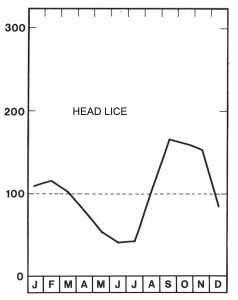
In scalp hair, the lice mainly keep to the quietest areas: In the neck and behind the ears.
Age and sex. Lice are not equally common to all people. In young children – under 4 years – head lice are seen equally often among boys and girls. As children get older lice are more common in girls/women. In men older than 18 years of age, head lice are virtually an unknown phenomenon.
Race. Lice can customize their color according to the color of the scalp of the person on whom they live. This trick that protects against premature discovery is only possible to do one time for each individual louse in its lifetime. That is why white people lice are dirty-white or grayish color. Lice on black people are dark and the North American Indians’ lice are reddish. The lice also make more permanent adjustments to the scalp hair, found in different human races. Hairs on black people have oval cross section. Lice on black people are so well adapted to grip the hair that they cannot live in Scandinavian hair which has a more round cross section. People of the Eskimo race have lice, which are slightly different from ours but closely related to Chinese lice. In England, where the population comprises a large number of immigrants from other parts of the world, entomologists have investigated the types of lice that infest English (white) schoolchildren. The entomologists found that the lice were of the Scandinavian type. Other ethnic groups had their own types of lice and the lice only migrated within the groups. It weakens the assumption that lice be brought here by people who come from distant parts of the world. The lice found in Denmark are likely to be particularly well adapted to living in the hair that predominates in Denmark.
Seasonal variation. Judging from the documents sent to the Danish National Pest Infestation Laboratory, head lice are an autumn phenomenon that culminates in September.
Periodic variation. We do not know why head lice during periods become more frequent. A simple explanation of the change in the frequency in lice infections could be that the lice, which are not effectively controlled will in more and more infections. If there is a period of time with too many lice infestations, scalp inspections, information and eradication are typical measures taken. After a few years the number of infestations has decreased to such an extent that people are not as prepared for them. This means that once again the conditions are ideal for the lice, and when the number of infestations increases, eradication measures, etc., are taken. This suggests that we should always be prepared to detect lice.




